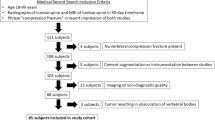Abstract
Objective
The aim of the present study was to compare the reliability and agreement between a computer tomography-based method (CT) and digitalised 2D radiographs (XR) when measuring change in dorsal angulation over time in distal radius fractures.
Materials and methods
Radiographs from 33 distal radius fractures treated with external fixation were retrospectively analysed. All fractures had been examined using both XR and CT at six times over 6 months postoperatively. The changes in dorsal angulation between the first reference images and the following examinations in every patient were calculated from 133 follow-up measurements by two assessors and repeated at two different time points. The measurements were analysed using Bland–Altman plots, comparing intra- and inter-observer agreement within and between XR and CT.
Results
The mean differences in intra- and inter-observer measurements for XR, CT, and between XR and CT were close to zero, implying equal validity. The average intra- and inter-observer limits of agreement for XR, CT, and between XR and CT were ± 4.4°, ± 1.9° and ± 6.8° respectively.
Conclusions
For scientific purpose, the reliability of XR seems unacceptably low when measuring changes in dorsal angulation in distal radius fractures, whereas the reliability for the semi-automatic CT-based method was higher and is therefore preferable when a more precise method is requested.




Similar content being viewed by others
References
Keats TE, Teeslink R, Diamond AE, Williams JH. Normal axial relationships of the major joints. Radiology. 1966;87(5):904–7.
Van der Linden W, Ericson R. Colles' fracture. How should its displacement be measured and how should it be immobilized? J Bone Joint Surg Am. 1981;63(8):1285–8.
Kreder HJ, Hanel DP, McKee M, Jupiter J, McGillivary G, Swiontkowski MF. X-ray film measurements for healed distal radius fractures. J Hand Surg. 1996;21(1):31–9.
Johnson PG, Szabo RM. Angle measurements of the distal radius: a cadaver study. Skeletal Radiol. 1993;22(4):243–6.
Friberg S, Lundstrom B. Radiographic measurements of the radio-carpal joint in normal adults. Acta Radiol Diagn. 1976;17(2):249–56.
Medoff RJ. Essential radiographic evaluation for distal radius fractures. Hand Clin. 2005;21(3):279–88.
Thomason K, Smith KL. The reliability of measurements taken from computer-stored digitalised x-rays of acute distal radius fractures. J Hand Surg Eur Vol. 2008;33(3):369–72.
Bland JM, Altman DG. Statistical methods for assessing agreement between two methods of clinical measurement. Lancet. 1986;1(8476):307–10.
Bozentka DJ, Beredjiklian PK, Westawski D, Steinberg DR. Digital radiographs in the assessment of distal radius fracture parameters. Clin Orthop Relat Res. 2002;397:409–13.
Grainger AJ, Duryea J, Elliott JM, Genant HK. The evaluation of a new digital semi-automated system for the radiological assessment of distal radial fractures. Skeletal Radiol. 2002;31(8):457–63.
Miyake J, Murase T, Yamanaka Y, Moritomo H, Sugamoto K, Yoshikawa H. Comparison of three dimensional and radiographic measurements in the analysis of distal radius malunion. J Hand Surg Eur Vol. 2013;38(2):133–43.
Selvik G. Roentgen stereophotogrammetry. A method for the study of the kinematics of the skeletal system. Acta Orthop Scand Suppl. 1989;232:1–51.
De Bruin PW, Kaptein BL, Stoel BC, Reiber JH, Rozing PM, Valstar ER. Imaged-based RSA: roentgen stereophotogrammetric analysis based on 2D–3D image registration. J Biomech. 2008;41(1):155–64.
Nysjö J, Christersson A, Malmberg F, Sintorn I-M, Nyström I. Towards user-guided quantitative evaluation of wrist fractures in CT images. In: Bolc L, Tadeusiewicz R, Chmielewski L, Wojciechowski K, editors. Computer vision and graphics. Heidelberg: Springer Berlin; 2012. p. 204–11.
Nysjö J, Christersson A, Sintorn I-M, Nyström I, Larsson S, Malmberg F. Precise 3D angle measurements in CT wrist images. In: Petrosino A, editor. Image analysis and processing – ICIAP 2013. Berlin Heidelberg: Springer; 2013. p. 479–88.
Christersson A, Sanden B, Larsson S. Prospective randomized feasibility trial to assess the use of rhPDGF-BB in treatment of distal radius fractures. J Orthop Surg Res. 2015;10:37.
Canny J. A computational approach to edge detection. IEEE Trans Pattern Anal Mach Intell. 1986;PAMI-8(6):679–98.
Lorensen WE, Cline HE. Marching cubes: a high resolution 3D surface construction algorithm. SIGGRAPH Comput Graph. 1987;21(4):163–9.
Lai Y-K, Hu S-M, Martin RR, Rosin PL. Rapid and effective segmentation of 3D models using random walks. Comput Aided Geom Des. 2009;26(6):665–79.
Besl PJ, McKay ND. A method for registration of 3-D shapes. IEEE Trans Pattern Anal Mach Intell. 1992;14(2):239–56.
Fischler MA, Bolles RC. Random sample consensus: a paradigm for model fitting with applications to image analysis and automated cartography. Commun ACM. 1981;24(6):381–95.
Escaramis G, Ascaso C, Carrasco JL. The total deviation index estimated by tolerance intervals to evaluate the concordance of measurement devices. BMC Med Res Methodol. 2010;10:31.
Biswas D, Bible JE, Bohan M, Simpson AK, Whang PG, Grauer JN. Radiation exposure from musculoskeletal computerized tomographic scans. J Bone Joint Surg Am. 2009;91(8):1882–9.
Author information
Authors and Affiliations
Corresponding author
Ethics declarations
Conflicts of interest
The authors declare that they have no conflicts of interest.
Rights and permissions
About this article
Cite this article
Christersson, A., Nysjö, J., Berglund, L. et al. Comparison of 2D radiography and a semi-automatic CT-based 3D method for measuring change in dorsal angulation over time in distal radius fractures. Skeletal Radiol 45, 763–769 (2016). https://doi.org/10.1007/s00256-016-2350-6
Received:
Revised:
Accepted:
Published:
Issue Date:
DOI: https://doi.org/10.1007/s00256-016-2350-6




